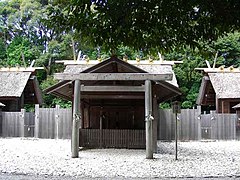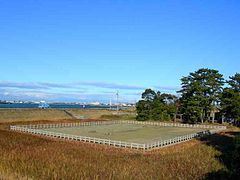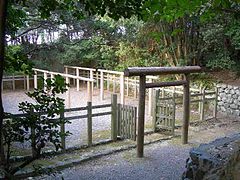Ise-jingū
The Ise-jingū ( Japanese 伊 勢 神宮 ; also Ise-Daijingū ( 伊 勢 大 神宮 ); for example: (large) shrine (s) of Ise ; official name actually just Jingū ) is a Shintō shrine and is considered in the shrine Shintō as the highest sanctuary in Japan . It is located in the present-day city of Ise (formerly Uji-Yamada) in the Mie prefecture and consists of an extensive building complex with two main shrines , the Inner Shrine ( 内 宮 Naikū ) and the Outer Shrine ( 外 宮 Gekū ) about six kilometers away , as well 125 side shrines (91 of which belong to the Naikū, 32 to the Gekū). In addition, the shrine also has three affiliated museums, a library and a number of other facilities for the production of the products required for the ceremonies, which are not only located in Ise or the prefecture of Mie.
Currently around six million people make pilgrimages to the shrine each year (this pilgrimage is called O-Ise-Mairi ). According to tradition, the gekū and then the naikū are visited first, if the time available is only the naikū. A particularly famous pilgrimage was that of Admiral Tōgō Heihachirō , who entered the bay of Ise with his entire fleet after the victorious Russo-Japanese War to show his gratitude.
The main shrines are not open to the public, they can only be viewed from a distance behind high fences. In addition, not all of the side shrines are located on the actual Naikū or Gekū grounds.
The Ise-jingū is also known for its archaic and simple architectural style called Shinmei-zukuri ( 神明 造 ), which is most common in Mie Prefecture . The Ise-jingū specifically uses a style variant called yuitsu shinmei-zukuri ( 唯一 神明 造 ), which, as the name suggests, is unique to this shrine (yuitsu) .
Both Naikū and Gekū have a variety of buildings that appear in both shrines. This includes u. a. the Saikan , a hall for ritual purification for the more than 100 priests, in which they have to stay for a night or two in order to free their minds from worldly things. In the Saikan there are special baths in which meals are only prepared over holy fire (without any aids). Next to the Saikan are the Anzaisho , special buildings for visitors to the imperial family.
Naiku
The official name of the Naikū is Kōtai-jingū . Traditional depictions say it was built about 2,000 years ago. His main goddess ( Kami ) is Amaterasu , sun goddess and ancestor of the Japanese imperial family , who was worshiped in the imperial palace of Yamato before the shrine was built. After a period of severe epidemics and natural disasters, Sujin- tennō is said to have commissioned the princess Toyosuki-irihime-no-mikoto to shrink Amaterasu in another place, which initially made the eastern Nara basin the place of worship of Amaterasu. Toyosuki-irihime no mikoto thus became the first Saishu , i.e. H. unmarried princess from the imperial family who acted as high priestess at the shrine of the Amaterasu. Suinin- tennō then later commissioned the princess Yamatohime no mikoto to find the perfect place to worship Amaterasu. After a hike through the regions of Ōmi and Mino , Yamatohime no mikoto is said to have finally reached Ise in the year 5 and heard Amaterasu say that she wanted to live forever in Ise, where the wind of the kami blows and the land through the rich springs of Berg and the sea be blessed.
The Naikū is located in Ujitachi-cho in a hilly area of around 5,500 hectares, almost all of which are overgrown with trees. 3,500 hectares of this were planted with Hinoki false cypresses in 1926 , which form the wood stock with which the ritual new construction of all buildings in Ise-jingū is to be contested every 20 years. This ritual is called Shikinen-sengū (cf. Sengū ), was prescribed by Temmu -tennō and performed for the first time by Jitō -tennō. The current building dates from the 62nd Shikinen-sengū of 2013 (October 2 in Naikū, October 5 in Gekū), the next new building is due for October 2033 .
At the entrance to the Naikū site is the Uji Bridge (Uji-bashi) , below which the sacred Isuzu River flows. Crossing the Isuzu over the approximately one hundred meter long bridge with the two large torii at both ends is intended to cleanse the visitors before they enter the actual area of the shrine. Before the actual worship of Amaterasu inside, the believers have the opportunity, in good weather, to wash their hands and rinse their mouths on a bank of the Isuzu (Mitarashi) . In bad weather, a traditional pool for ablutions is available, which as well as here in Geku Temizusha is.
One of the three throne insignia of Japan , the mirror Yata no kagami , is said to have been kept in the Naikū since the 6th year of Sujin-tennō's reign and is supposed to serve there as a shintai . Toyosuki-irihime no mikoto is said to have received the mirror with him. Since it is not accessible to the public, no reliable statement can be made about it.
Gekū
The Gekū (actual name: Toyouke Dai-jingū ) is said to have been built at the behest of Amaterasu in 478, the 22nd year of Yūryaku -tennō's reign . The main kami of this shrine is Toyouke, a food and industrial deity, and is primarily associated with growing rice. According to the myth, 1,500 years ago, she was called to Ise from the Tanba region (northern part of today's Kyoto prefecture ) at the request of Amaterasu to serve the holy meals for them. The necessary ceremony (Higoto-Asayu-Omikesai) is said to have been carried out in the morning and in the evening without exception since the founding of the Gekū and takes place in both the Gekū and the Naikū in 16 different buildings.
The Gekū is in Toyokawa-chō. Access to it is also via a bridge, here called Hiyoke-bashi . Its structure is essentially identical to that of the Naikū.
Museums and library
The three museums and the library are located on Mount Kurata, between Naikū and Gekū. The museums include the History Museum ( 神宮 徴 古 館 Jingū Chōkokan ), the Agriculture Museum ( 神宮 農業 館 Jingū Nōgyōkan ) and the Museum of Fine Arts ( 神宮 美術館 Jingū Bijutsukan , opened in 1993 to celebrate the 61st Shikinen-sengū ). All exhibit artifacts that have an indirect or direct relationship with the shrine. In the library ( 神宮 文庫 Jingū Bunko ) there are over 260,000 books and other data carriers about Shintō, religion, literature and other topics related to the shrine.
Other bodies
The sacred rice fields (Jingū-Shinden) are located in Kusube-chō in Ise and occupy 30,000 m². This is where the rice is harvested, which is offered to the kami in the shrine. The growth of the rice is accompanied by special Shinto ceremonies.
The facilities for extracting the holy salt are located on the grounds of the Mishiodono-jinja in Shō, Futami -chō, Ise and occupy 27,785 m². From the beach of Mishiohama in Nishi, Futami-chō, Ise the salt water is directed to the Mishio-kumiiresho. It is then evaporated in the Mishio-yakisho and later pressed into solid blocks.
In the Misono fields, vegetables and fruit are grown for offerings. They are located in Mizoguchi, Futami-chō, Ise and occupy 19,751 m².
In the city of Matsusaka there are two shrines in which the fabric for the sacred garments is woven: the Kanhatori-hatadono-jinja ( 神 服 織機 殿 神社 ) in Ōgaito-chō, for silk, and the Kan'omi-hatadono-jinja ( 神 麻 続 機 殿 神社 ) in Iguchinaka-chō, for hemp.
In Kuzaki-chō in the city of Toba , enjoy facilities for constitution of abalone (awabi) for the offerings. In Shinojima , Minamichita , Chita-gun , Aichi Prefecture , there are facilities for drying special types of fish for the offerings. In Minomura, Meiwa , Taki-gun in Mie Prefecture, there are facilities for making the sacred pottery (kawarake) used to make the offerings. They are made without glaze . Annual production is around 60,000 pieces.
Festivals
The following is an (incomplete) list of the more well-known festivities that are celebrated in Ise-Jingū or parts of it over the year. The festivals are divided into Koreisai (annual festivals on fixed dates, of which there are around 1600) and Rinjisai (festivals for special events in Japan or the imperial family).
| date | Surname | meaning |
|---|---|---|
| January 1st | Saitan-sai | New year celebration |
| January 3rd | Genshi-sai | Celebration of the founding of the imperial family by Ninigi , a grandson of the Amaterasu. |
| January 7th | Shōwa-Tennō-sai-yohai | Commemoration in honor of the Shōwa-tennō on the day of his death, parallel to the same ceremony in the Imperial Palace |
| 11th January | Ichigatsu-juichinichi-mike | Food sacrifice ceremonies for Amaterasu and other Kami in Naikū, later dance and music |
| February 11th | Kenkoku Kinen-sai | Celebration of the Japanese founding day |
| 17.-23. February | Kinen-sai | Prayer for a successful harvest with the participation of an imperial envoy |
| March equinox | Misono-sai | In the Misono fields, prayers are made for a successful harvest |
| Equinox in March & September | Shunki-koreisai-yohai | Prayers in memory of the imperial ancestors, parallel to the same ceremony in the imperial palace |
| early April | Shinden-geshu-sai | Sowing the rice in the sacred rice fields, which will later be used in the Kanname-sai |
| 3rd of April | Jimmu Tennō-sai-yohai | Commemoration in honor of Jimmu-tennō on the day of his death, parallel to the same ceremony in the Imperial Palace |
| May 1st & October 1st | Kanmiso-hoshoku-hajime-sai | Weaving of sacred silk and sacred hemp for the Kanmiso-sai |
| May 13th & October 13th | Kanmiso-hoshoku-chinsha-sai | Thanksgiving ceremonies for the successful Kanmiso-hoshoku-hajime-sai |
| May 14th & August 4th | Kazahinomi-sai | Prayer for mild winds, offerings for a weather conducive to the harvest |
| May 14th & October 14th | Kanmiso-sai | Ceremony of offering sacred clothing to Amaterasu; only takes place in the Naikū and its side shrine, Ara-matsuri-no-miya; goes back to mythological ideas of Amaterasu with a loom in Takamanohara |
| early May | Shinden-otaue-hajime-shiki | Ceremony to transplant the rice sown in Shinden-geshu-sai |
| June 1st, October 1st & December 1st | Misakadono-sai | Prayers to the sake kami for successful fermentation of the sake that is served during tsukinami-sai and Kanname-sai |
| June 15th, October 15th & December 15th | Okitamanokami-sai | Ceremony in the Naikū to worship Okitamanokami, protector of the land that is the site of the Naikū's main shrine |
| June 15th, October 15th & December 15th | Miura | Prophecies on naiku to select the priests who are qualified to participate in tsukinami-sai and Kanname-sai |
| 15-25 June & 15-17 December | Tsukinami-sai | Imperial gift offering ceremony; originally monthly and the oldest ceremonial in Ise-Jingū |
| June 30th & December 31st | Oharai | Purification ceremony for priests and musicians at the imperial court; also takes place in other months in which many ceremonies were performed, always on the last day of the month |
| beginning of September | Nuibo-sai | Harvesting the fully grown bundles of rice in the sacred rice fields for the later Kanname-sai |
| 5th October | Mishiodono-sai | Prayers for successful salt extraction and protection for those involved |
| 15-17 October | Kanname-sai | Thanksgiving ceremony for a rich harvest. The first ears of wheat harvested from the shrine's sacred rice fields (shinden) are offered to Amaterasu, who she eats with Toyouke. An imperial emissary brings sacred clothing as offerings. |
| 23-29 November | Niiname-sai | The Tennō in his capacity as the highest Shintō priest offers Amaterasu from the first rice harvest in a special building at the imperial court and then dines with her, representative of the Japanese people. This most important of all Shinto festivals is accompanied in the Naikū, Gekū and some side shrines with special ceremonies with the participation of an imperial envoy. |
| 23rd of December | Tencho-sai | Celebration of the incumbent Tennō's birthday, currently Naruhito . |
Quotes
The Ise-jingū has often made a big impression on its visitors, including Japanese visitors from abroad, even those who had no previous connection to Shintō:
"The Isé Shrine to Amaterasu, the most revered Shinto center of divine unification, has the simple freshness, the gentle delicacy and the gleaming purity of a virtous woman."
"The Ise shrine for Amaterasu, the most revered Shinto center of divine union, possesses the simple freshness, gentle tenderness and brilliant purity of a virtuous woman."
“On more than one occasion, I entered the precincts of some great Shintô center, particularly Ise, with groups of foreigners who knew absolutely nothing about it and were not particularly interested, and yet were so deeply struck with the atmosphere they found there that some of them actually shed tears. "
"On more than one occasion I entered the grounds of a large Shinto center, especially Ise, with a group of foreigners who knew absolutely nothing about it and were not particularly interested in it, and yet were so deeply impressed by the atmosphere they found, that some of them actually shed tears. "
literature
- Taryo Obayashi and Yoshio Watanabe: Ise and Izumo: the shrines of Shintoism . Herde publishing house, Freiburg im Breisgau / Basel / Vienna 1982, ISBN 3-451-19516-X .
- Yasuhiro Ishimoto (photographs): Ise jingū . Kabushikikaisha Iwanami Shote, Tokyo 1995, ISBN 4-00-008061-X .
- Tino Mager: The wrapping of eternity: Japan's Ise shrines - masterpieces of the hidden . In: Michael Fisch , Ute Seiderer (Hrsg.): Skin and shell - envelope and packaging . Rotbuch, Berlin 2014, ISBN 978-3-86789-206-3 .
Web links
- Ise Shrine website (Japanese, English, Chinese, Korean)
- Ise Shrine , entry in the Wiki project Kami graphy of the University of Vienna
- Introductory series on the website of the Jinja Honcho (Association of Shinto Shrines) (English)
- Nakanishi Masayuki: "Ise Shinkō" . In: Encyclopedia of Shinto. Kokugaku-in , November 11, 2006 (English)
- shinmei-zukuri 神明 造 in JAANUS (Japanese Architecture and Art Net Users System) - English
Individual evidence
- ↑ yuitsu shinmei-zukuri 唯一 神明 造 . In: JAANUS. Retrieved September 20, 2017 (English).
- ↑ Ise's renewal ceremony , Green Shinto Blog , October 18, 2013 (accessed January 9, 2015)
- ↑ The meaning of Shintô; the primeval foundation of creative spirit in modern Japan . Dutton, New York 1935, p. 214
- ^ Shintô. At the Fountain-head of Japan . George Allen & Unwin, London 1967, p. 92
Coordinates: 34 ° 27 ′ 18 ″ N , 136 ° 43 ′ 33 ″ E






















